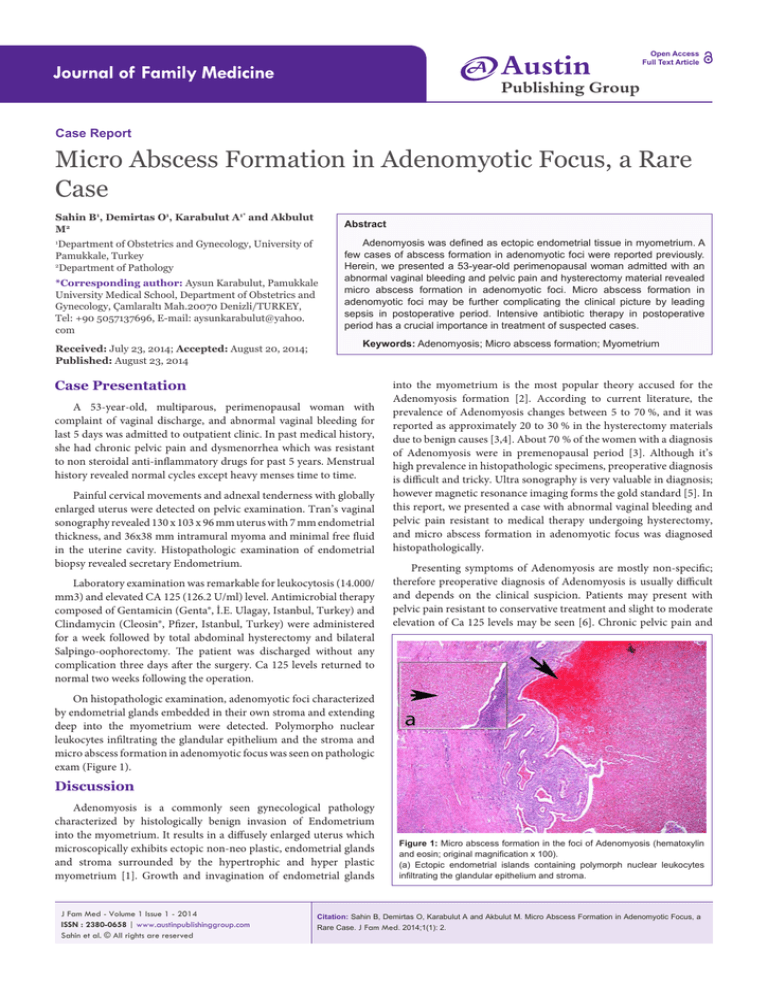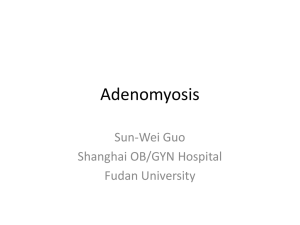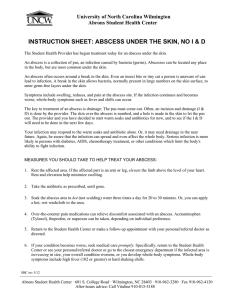
A
Journal of Family Medicine
Austin
Open Access
Full Text Article
Publishing Group
Case Report
Micro Abscess Formation in Adenomyotic Focus, a Rare
Case
Sahin B1, Demirtas O1, Karabulut A1* and Akbulut
M2
Abstract
Department of Obstetrics and Gynecology, University of
Pamukkale, Turkey
2
Department of Pathology
1
*Corresponding author: Aysun Karabulut, Pamukkale
University Medical School, Department of Obstetrics and
Gynecology, Çamlaraltı Mah.20070 Denizli/TURKEY,
Tel: +90 5057137696, E-mail: aysunkarabulut@yahoo.
com
Received: July 23, 2014; Accepted: August 20, 2014;
Published: August 23, 2014
Adenomyosis was defined as ectopic endometrial tissue in myometrium. A
few cases of abscess formation in adenomyotic foci were reported previously.
Herein, we presented a 53-year-old perimenopausal woman admitted with an
abnormal vaginal bleeding and pelvic pain and hysterectomy material revealed
micro abscess formation in adenomyotic foci. Micro abscess formation in
adenomyotic foci may be further complicating the clinical picture by leading
sepsis in postoperative period. Intensive antibiotic therapy in postoperative
period has a crucial importance in treatment of suspected cases.
Keywords: Adenomyosis; Micro abscess formation; Myometrium
Case Presentation
A 53-year-old, multiparous, perimenopausal woman with
complaint of vaginal discharge, and abnormal vaginal bleeding for
last 5 days was admitted to outpatient clinic. In past medical history,
she had chronic pelvic pain and dysmenorrhea which was resistant
to non steroidal anti-inflammatory drugs for past 5 years. Menstrual
history revealed normal cycles except heavy menses time to time.
Painful cervical movements and adnexal tenderness with globally
enlarged uterus were detected on pelvic examination. Tran’s vaginal
sonography revealed 130 x 103 x 96 mm uterus with 7 mm endometrial
thickness, and 36x38 mm intramural myoma and minimal free fluid
in the uterine cavity. Histopathologic examination of endometrial
biopsy revealed secretary Endometrium.
Laboratory examination was remarkable for leukocytosis (14.000/
mm3) and elevated CA 125 (126.2 U/ml) level. Antimicrobial therapy
composed of Gentamicin (Genta®, İ.E. Ulagay, Istanbul, Turkey) and
Clindamycin (Cleosin®, Pfizer, Istanbul, Turkey) were administered
for a week followed by total abdominal hysterectomy and bilateral
Salpingo-oophorectomy. The patient was discharged without any
complication three days after the surgery. Ca 125 levels returned to
normal two weeks following the operation.
into the myometrium is the most popular theory accused for the
Adenomyosis formation [2]. According to current literature, the
prevalence of Adenomyosis changes between 5 to 70 %, and it was
reported as approximately 20 to 30 % in the hysterectomy materials
due to benign causes [3,4]. About 70 % of the women with a diagnosis
of Adenomyosis were in premenopausal period [3]. Although it’s
high prevalence in histopathologic specimens, preoperative diagnosis
is difficult and tricky. Ultra sonography is very valuable in diagnosis;
however magnetic resonance imaging forms the gold standard [5]. In
this report, we presented a case with abnormal vaginal bleeding and
pelvic pain resistant to medical therapy undergoing hysterectomy,
and micro abscess formation in adenomyotic focus was diagnosed
histopathologically.
Presenting symptoms of Adenomyosis are mostly non-specific;
therefore preoperative diagnosis of Adenomyosis is usually difficult
and depends on the clinical suspicion. Patients may present with
pelvic pain resistant to conservative treatment and slight to moderate
elevation of Ca 125 levels may be seen [6]. Chronic pelvic pain and
On histopathologic examination, adenomyotic foci characterized
by endometrial glands embedded in their own stroma and extending
deep into the myometrium were detected. Polymorpho nuclear
leukocytes infiltrating the glandular epithelium and the stroma and
micro abscess formation in adenomyotic focus was seen on pathologic
exam (Figure 1).
Discussion
Adenomyosis is a commonly seen gynecological pathology
characterized by histologically benign invasion of Endometrium
into the myometrium. It results in a diffusely enlarged uterus which
microscopically exhibits ectopic non-neo plastic, endometrial glands
and stroma surrounded by the hypertrophic and hyper plastic
myometrium [1]. Growth and invagination of endometrial glands
J Fam Med - Volume 1 Issue 1 - 2014
ISSN : 2380-0658 | www.austinpublishinggroup.com
Sahin et al. © All rights are reserved
Figure 1: Micro abscess formation in the foci of Adenomyosis (hematoxylin
and eosin; original magnification x 100).
(a) Ectopic endometrial islands containing polymorph nuclear leukocytes
infiltrating the glandular epithelium and stroma.
Citation: Sahin B, Demirtas O, Karabulut A and Akbulut M. Micro Abscess Formation in Adenomyotic Focus, a
Rare Case. J Fam Med. 2014;1(1): 2.
Karabulut A
Austin Publishing Group
abnormal vaginal bleeding are the prominent symptoms in our case
and moderately elevated Ca 125 level was also noted on laboratory
exam.
given preoperatively for suspected endometritis. Only elevated white
blood cell count and CRP levels were noted, and they were resolved
with continuation of antibiotic therapy.
Abscess formation in endometriomas was reported previously,
but only one case of abscess formation and one case of micro abscess
formation in adenomyotic foci were detected in our literature
search [7,8]. Erguvan, et al reported a 54-year-old, postmenopausal
woman suffering from inguinal pain, night sweats, and hot flashes.
A 95x85 mm leimyoma like lesion with a 53 mm x 43 mm cystic
space in uterus mimicking malignancy was detected on sonography
exam. Postoperative pathologic exam revealed abscess formation
in adenomyotic focus. Although the patient had fewer in early
postoperative period, later follow-up was uneventful. It was the first
case of abscess formation in Adenomyosis reported in literature.
However they could not isolate any microorganism from the lesion
[9]. On the other hand, our patient did not have fewer despite
elevated leukocyte count in postoperative period. Preoperative use of
wide spectrum antibiotics probably played a role in this scene.
Conclusion
Shu-Fen Weng, et al described another case of Adenomyosis
with micro abscess formation in a 50-year-old nulliparous women
presenting with persistent vaginal bleeding, lower abdominal pain
and fever, and sepsis was developed in postoperative period [10].
Different from the previous one, micro abscess formation looked
like multiple separate islands, and polymorph nuclear leukocyte
infiltration in ectopic endometrial foci were detected in this case.
Similarly, we detected polymorpho nuclear leukocyte infiltration and
micro abscess formation on pathologic exam, but probably due to
early antibiotic therapy postoperative period was uneventful in ours.
Although Adenomyosis is known as estrogen-dependent
lesion, interestingly both cases reported previously [9,10] were in
perimenopausal period. The same was true for our case. Under the
light of current literature, it is hard to interpret, whether Adenomyosis
is aggravated in perimenopausal period due to unbalanced estrogen
and they become vulnerable to abscess formation. In background
history of all cases chronic pain resistant to medical treatment was
the common finding. In previous two reports sepsis was developed
postoperatively [9,10]. Luckily, it was not the situation in our case,
probably due to antibiotic therapy (Gentamicine and Clindamycin)
J Fam Med - Volume 1 Issue 1 - 2014
ISSN : 2380-0658 | www.austinpublishinggroup.com
Sahin et al. © All rights are reserved
Submit your Manuscript | www.austinpublishinggroup.com
In conclusion, Adenomyosis may present with nonspecific signs
and symptoms, and micro abscess formation in adenomyotic foci
may further complicate situation and carry risk of postoperative
sepsis. Surgery is the main treatment modality in cases refractory
to medical treatment, and intensive antibiotic therapy is required to
minimize the risk of sepsis.
References
1. Benagiano G, Brosens I. History of adenomyosis. Best Pract Res Clin Obstet
Gynaecol. 2006; 20: 449-463.
2. Ferenczy A. Pathophysiology of adenomyosis. Hum Reprod Update. 1998;
4: 312-322.
3. Wallwiener M, Taran FA, Rothmund R, Kasperkowiak A, Auwärter G,
Ganz A, et al. Laparoscopic supracervical hysterectomy (LSH) versus
total laparoscopic hysterectomy (TLH): an implementation study in, 952
patients with an analysis of risk factors for conversion to laparotomy and
complications, and of procedure-specific re-operations. Arch Gynecol Obstet.
2013; 288: 1329-1339.
4. Hendrickson MR, Kempson RL. Non-neoplastic conditions of the myometrium
and uterine serosa. 4th edn. Fox H, editor. In: Obstetrical and Gynaecological
Pathology. Churchill-Livingstone. 1995: 511–518.
5. Taran FA, Stewart EA, Brucker S. Adenomyosis: Epidemiology, Risk
Factors, Clinical Phenotype and Surgical and Interventional Alternatives to
Hysterectomy. Geburtshilfe Frauenheilkd. 2013; 73: 924-931.
6. Babacan A, Kizilaslan C, Gun I, Muhcu M, Mungen E, Atay V. CA 125 and
other tumor markers in uterine leiomyomas and their association with lesion
characteristics. Int J Clin Exp Med. 2014; 7: 1078-1083.
7. Martino CR, Haaga JR, Bryan PJ. Secondary infection of an endometrioma
following fine-needle aspiration. Radiology. 1984; 151: 53-54.
8. Lipscomb GH, Ling FW, Photopulos GJ. Ovarian abscess arising within an
endometrioma. Obstet Gynecol. 1991; 78: 951-954.
9. Erguvan R, Meydanli MM, Alkan A, Edali MN, Gokce H, Kafkasli A. Abscess
in adenomyosis mimicking a malignancy in a 54-year-old woman. Infect Dis
Obstet Gynecol. 2003; 11: 59-64.
10.Weng SF, Yang SF, Wu CH, Chan TF. Microabscess within adenomyosis
combined with sepsis. Kaohsiung J Med Sci. 2013; 29: 400-401.
Citation: Sahin B, Demirtas O, Karabulut A and Akbulut M. Micro Abscess Formation in Adenomyotic Focus, a
Rare Case. J Fam Med. 2014;1(1): 2.
J Fam Med 1(1): id1004 (2014) - Page - 02





